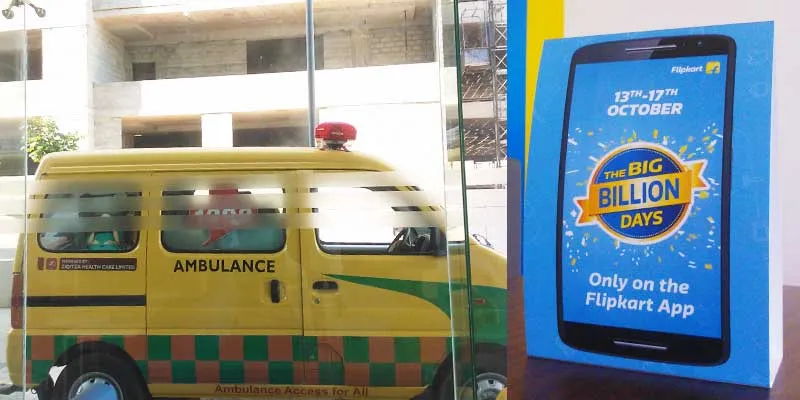An ambulance, a data centre and a 1000 member team behind the $300M Big Billion Days
Before InMobi came in, Cessna Business Park in Bengaluru was home to only multinationals like Cisco, LG and a boutique hotel Aloft. But things have changed over the last few months. Flipkart had announced the opening of a unique office inside the Special Economic Zone.
An unusual welcome greeted the visitors for the last few days. An ambulance was parked beside the entrance, probably on account of the unusual working hours owing to the Big Billion Days sale. Unique in many ways, Flipkart has undoubtedly built one of the most creative office spaces. The building employs more than 1,000 product and engineering team members of the e-commerce giant, and almost half of them stayed overnight for the last week. When I visited, there was peace and calm, certainly not what you would expect on this special Saturday. After all, it was the fifth day of Big Billion Days, and there was one more day to go for the largest e-commerce sale in India to end. And with Amazon and Snapdeal scheduling their sale at the same time, this just got bigger. The numbers garnered by all three players over the last week are massive. But equally amazing are the engineering teams that supported the massive influx of traffic without much crashes/down time.

Sleep-deprived excitement and robust preparations
When Peeyush Ranjan, Chief Technology Officer and Head of Engineering; Punit Soni, Chief Product Officer and Ankit Nagori, Chief Business Officer, Flipkart, entered the meeting room, one could sense a layer of tiredness looming under the excitement of selling half a million phones in 10 hours only a couple of days ago. The trio had managed to sleep for an average total of less than 15 hours in the last five days.
Peeyush was proud of the infrastructure(new servers and networks) built over the last few months at Flipkart which could support as much as 15 times the usual traffic on website and app. Some of the major updates made to the app before the sale include:
- Reducing the app size by almost 50 percent and memory footprint to 10 MB, enabling faster downloads and updates (please note that the size of Snapdeal Android app is 8.42MB and that of Amazon(varying on different devices) is 9.25MB)
- Intelligent cachingon the device enabled the app to perform faster even in bad/slow networks
- Robust infrastructure resulted in 99.5 percent crash-free experience by users during the event. Given the figure of 150 million visits during the sale, 0.5 percent accounts for 7,50,000 crashes which is still a big number
- Richer checkout experience resulting in 10 per cent more conversions
- By caching a lot of information on the device, many instances of network failure and network switches were taken care of
There was emphasis on the app experience being uniform across all the varieties of smartphones.
Puneet says,
“From supply chain to customer service, mobile app to Ping, data centres to the core infrastructure, and security, we had to change everything in the architecture over the last year. This is probably the biggest technological transformation I’ve ever seen in any company.”
A total of six weeks of dedicated time went in to handle the second edition of Big Billion Days, but this will not be the case going forward. Peeyush says, “Ideally, we are building capabilities to an extent that the sale happens with ease and without much dedication of resource utilisation.”
Most of the team including Punit and Peeyush weren’t a part of Flipkart at the time of last BBD which faced some major issues owing of lack of infrastructure support to handle the scale of the event. Eventually, an apology letter was sent to the customers on behalf of the co-founders Sachin Bansal and Binny Bansal.

The approach and the challenges
Peeyush says,
“When you’re building a Boeing 747, you will test for all unexpected things. The last thing you want is to have issues with taking off or in-flight glitches. That’s the approach we took and hence fixed a lot of issues almost two to three weeks before the sale kicked off.”
Even with the above approach, following challenges kept the engineering team busy:
- What Flipkart didn’t take into account was the number of sellers signing into the platform to sell a specific item. Usually, 12-13 sellers were on-boarding to sell specific items, which surged to more than 100. They the company realised that the systems were capable to hold only one-fifth of what was expected
- The company had recently moved to a new data centre which requires a period of stabilisation. Also, unlike website traffic where there are tried and tested methods to take care of surge, it’s a completely different ball game when you’ve millions of people coming to a mobile app.
- Frauds: Ever since the company moved to marketplace model, it has been tackling frauds with technology. During the sale, the percentage of frauds hasn’t seen any significant change(and hence the number was higher). In one of the most common frauds, sellers put a fake item or jacked up the price during the sale. Automatic price detection and MRP detection products were monitoring the same. For example, if a Gucci bag was available for Rs 500, then there’s something wrong. Peeyush believes that the scale at which transactions happen at Flipkart, frauds cannot be handled operationally
- Ping(chat based app for shopping) was witnessing 80 chats per second with five new users popping up every second and 4..5 lakh users joined Ping during the sale.“We’re an e-commerce company and not a full-scale messaging company, so the infrastructure had to be built for this,” Peeyush notes.
The company had extended its supply chain network with new warehouses and delivery centres, and had built products which would automatically plan and forecast things.
Products that made this year’s Big Billion Days bigger:
- Instant return
- Industry standard exchange program for phones: Enter IMEI automatically detects the phone and estimates the price, deducts the same from the buying product and gives the updated price
- Seller mobile app updated version: Access to inventory, updates and analytics while travelling
- Call me back: If the user has an issue, he/she can tap the button and will receive a call within few minutes
There were about 85 new products launched in the last quarter and 200 in the last seven months. Punit believes that all this is flywheel of incremental innovation.
Impact on e-commerce landscape
India’s e-commerce market size will touch USD 16 billion by end of 2015. It’s interesting to note that together, Flipkart and its fashion-focused Myntra unit have a 60 per cent market share of Daily Active Users (DAU) out of India’s top six Android e-commerce apps. The following comment by Puneet summarizes the impact of Big Billion Days:
“It’s a statement that if you want to serve the Indian e-commerce market, majority of which will not use their laptops/desktops, you’ve to take the mobile-focused approach and we did it. We held the largest e-commerce sale in India on a 10 MB app and did it well.”
He adds,“We have arrived. This is one of the serious shots in being a world-class product tech company and India’s answer to the world.”
Some of the key figures from the sale are:
- Eight million units sold(3x of that of last year)
- 150 million visitsfrom across India(more than 90 percent on mobile app)
- 98 percent revenues on mobile phone
- Total of five million app downloads(Snapdeal claimed to have witnessed five million downloads in a single day)
- Sales worth USD 300 million
- Over 50 per cent of traffic came from smaller cities(with Nagpur, Indore, Coimbatore, Vishakhapatnam and Jaipur leading in sales)
- Orders from 10,000 unique pincodes
Ankit mentioned that hundred new millionaires (sellers) were made in this sale.
BBD 2016
Ankit says,
“This time we had Myntra participating in the sale and others participated in a quasi manner. Next year onward, we are planning to have an open sale, more of an e-commerce sale with 30 to 40 small e-commerce players coming together.”
Stay tuned for more updates on technology behind the e-commerce powerhouses of India.







